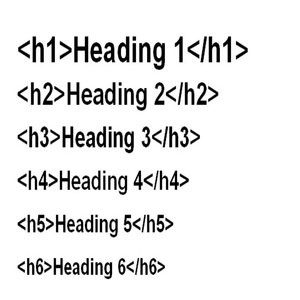Headings/ Headings Tags
Heading tags refer to the headings of the different paragraphs or sections of a page. A heading differentiates a particular section or paragraph from the rest of the page and makes it more readable and organized. There can be a maximum of six heading tags, which ranges from H1 to H6 and forms a top-down hierarchy, i.e., HI is at the top or more important, and H6 is at the bottom or least important. The headings should be used in order from top to down. You cannot skip any of the heading tags in between the sequence; otherwise, it will break the heading structure, which is not recommended for on-page SEO, i.e., H1 tag should be followed by the H2 tag, not by H3 or any other heading tag. Benefits of Headings in SEO/ Why is Important H1 tag?H1 tag is the most important tag of each of the pages of a website. Its purpose is to introduce the content of a page, to tell users what to expect from a page, or simply tell the name of the page. The relevant keywords or desired information at the top of the page is good for SEO. It allows users and search engines to read and understand your text. They make it easier for the users to understand what a post or page is about. Headings tell which parts of your content are important, how they are connected. So, we can say that headings act as signposts that guide readers through a page. Heading should be relevant so that readers could know what a page or section is about, or what to expect from a page or section. Furthermore, it also helps users to get back on track if they get lost. For example, a person who sells two-wheeler parts can create a page with a "Where to Buy Bicycle Parts" H1 tag. So, this heading tells Google that this page is about where to buy two wheeler parts, so it increases the chances of this page to rank for that query. Thus, Google will display this page to the right users, and thereby it helps reduce bounce rates, which in turn helps improve SEO. Some important instructions to optimize the headings
Next TopicSEO Optimized Domain Name
|
 For Videos Join Our Youtube Channel: Join Now
For Videos Join Our Youtube Channel: Join Now
Feedback
- Send your Feedback to [email protected]
Help Others, Please Share










